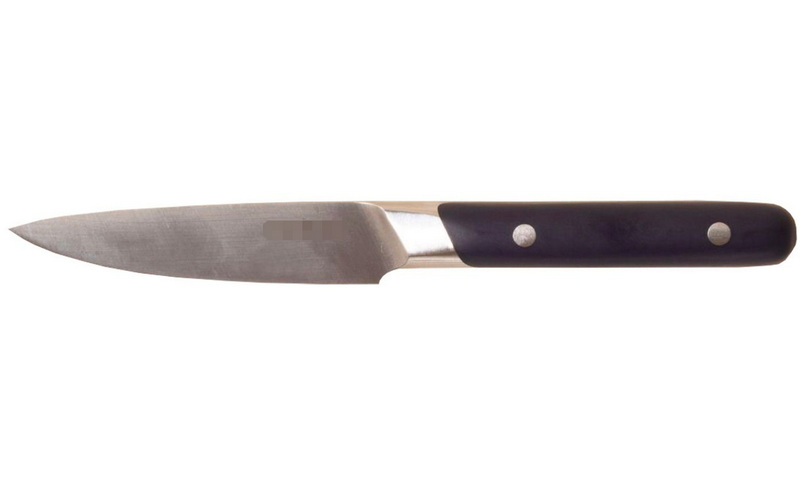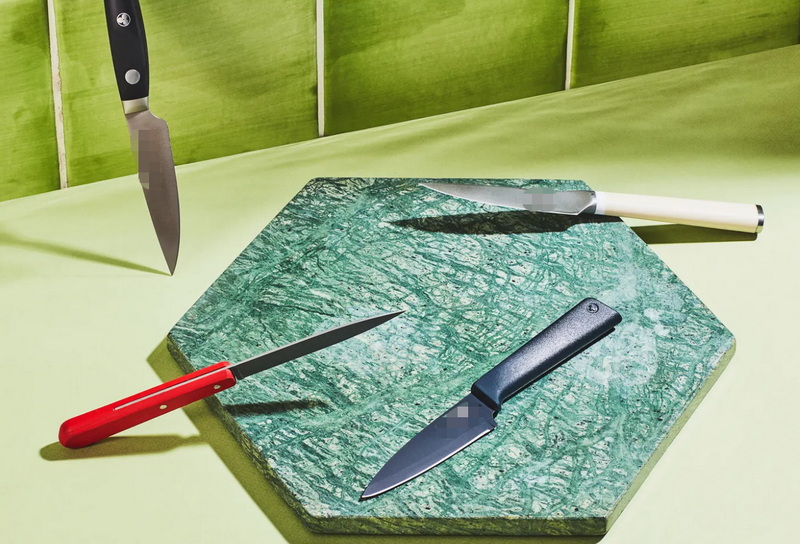- All
- Product Name
- Product Keyword
- Product Model
- Product Summary
- Product Description
- Multi Field Search
Views: 222 Author: Ann Publish Time: 2025-10-20 Origin: Site











Content Menu
● Key Features of Top Paring Knives in 2025
● Enhancing Precision: Additional Tips and Insights
>> Advanced Edge Finishes and Coatings
>> Benefits of Customized OEM Paring Knives
>> Paring Knife Maintenance in 2025
>> Paring Knife Uses Beyond Fruits and Vegetables
● How to Care for Your Paring Knife
● Paring Knife vs Other Knives
>> 1. What is the best blade material for a paring knife?
>> 2. How do I sharpen a paring knife at home?
>> 3. Can I use a serrated paring knife for all cutting tasks?
>> 4. How should I store my paring knife to keep it sharp?
>> 5. Are forged paring knives better than stamped?
Paring knives are essential tools in every kitchen, prized for their precision and versatility. As the year 2025 unfolds, innovations in materials, design, and ergonomics have pushed paring knives to new heights, enabling chefs and home cooks alike to perform intricate cutting tasks with ease. This article explores the best paring knives on the market in 2025, their features, and how to choose the perfect paring knife for your needs.

A paring knife is a small, versatile kitchen knife designed for precise tasks such as peeling, trimming, and detailed cutting. Typically, paring knives have blades between 2.5 to 4 inches long, with a sharp pointed tip to maneuver around curves and edges in fruits and vegetables. This compact size makes paring knives highly maneuverable, perfect for tasks where control is paramount.
The blade material determines the sharpness, durability, and maintenance ease of a paring knife. In 2025, the most popular materials include:
- High-carbon stainless steel: Combines corrosion resistance with excellent edge retention. This material is widely favored because it maintains a sharp edge longer and resists rust, making it practical for busy kitchens.
- Japanese VG-10 steel: Celebrated for its remarkable sharpness and durability. This high-quality steel is often used in premium paring knives where thin, acute edges are desirable.
- Damascus steel: Offers a beautiful layered aesthetic along with strong cutting performance. Damascus blades often stand out both visually and in performance, making them favorite collector pieces as well as functional tools.
New advances in steel treatment technologies have also improved the hardness and corrosion resistance of these materials, ensuring that paring knives in 2025 can withstand frequent use while maintaining precision.
Paring knives come in different blade shapes, each suited for specific tasks:
- Straight edge: Ideal for general peeling, slicing, and detailed work. The straight edge provides clean cuts on firm-skinned fruits and vegetables.
- Serrated edge: Perfect for cutting soft skins like tomatoes and delicate produce without crushing them. The serrations grip slippery surfaces, allowing for smoother slices.
- Bird's beak: The curved shape excels in intricate tasks such as garnishing and paring round fruits. Its unique contour allows the user to follow natural curves easily.
Choosing the right blade shape depends on your typical cutting needs. Many users keep more than one paring knife type to cover all precision cutting scenarios.
Ergonomics is a critical factor in modern paring knives. A well-designed handle minimizes hand fatigue and enhances grip security during detailed work.
Popular materials include:
- Wood (such as rosewood or walnut), which provide a warm, classic feel and often add to the aesthetic appeal.
- Durable polymers like G10 or Micarta, which are water-resistant, strong, and provide excellent textured grip surfaces.
- Stainless steel with textured or silicone inserts offers a sleek look while maintaining a non-slip hold.
Balanced weight distribution between blade and handle is also essential. Knives with handles that complement the blade weight reduce wrist strain and improve cutting control.
- Forged knives: These are crafted from a single piece of steel, heated, and hammered into shape. Forged paring knives provide exceptional strength, durability, and balance. They typically have a bolster (thick junction between blade and handle), offering finger protection and improved handling.
- Stamped knives: Made by cutting shapes out of steel sheets and then sharpening and polishing them. Stamped paring knives are lighter and generally more affordable, making them suitable for casual or beginner cooks.
Both styles have their benefits—choosing forged or stamped depends on your preference for weight, balance, and budget.

In 2025, many paring knives offer advanced edge finishes and coatings that enhance cutting precision and blade longevity:
- Ceramic coatings: Some blades are coated with ceramic layers to reduce friction and prevent food from sticking to the blade. This is particularly helpful when slicing sticky or moist items.
- Non-stick coatings: These coatings improve glide during cutting and simplify cleaning.
- Hollow ground edges: Knives with hollow ground edges create thin, sharp blades that excel at delicate slicing without resistance.
These enhancements tailor paring knives to specialized needs and elevate their performance beyond traditional models.
For kitchenware brands and retailers, OEM customization offers unique paring knives that reinforce brand identity and meet specific consumer expectations. Custom options include blade engraving, handle materials and colors, packaging designs, and personalized sharpening angles.
Customized paring knives allow brand differentiation in a competitive market, adding value through exclusivity and ergonomics tailored for target users.
Proper maintenance extends the life and precision of paring knives significantly:
- Sharpen with precision tools: Using whetstones, ceramic rods, or electric sharpeners specifically designed for small blades ensures optimal edge angles.
- Avoid dishwasher cleaning: High temperatures and harsh detergents degrade the blade and handle materials over time.
- Store properly: Use knife blocks, sheaths, or magnetic strips to protect the blade and prevent accidents.
- Regular honing: Frequent honing straightens the microscopic teeth on the blade edge, preserving cutting efficiency with minimal sharpening.
While paring knives are traditionally used for fruit and vegetable prep, their small size and maneuverability make them ideal for various more advanced culinary tasks:
- Deveining shrimp
- Removing seeds from peppers
- Segmenting citrus fruits
- Creating intricate garnishes
- Trimming fat and sinew from meat with precision
The ability to perform such detailed tasks highlights the paring knife's role as a multifunctional tool that no kitchen should be without.
Long-lasting sharpness depends on regular care:
- Hand wash only, avoid dishwasher.
- Dry immediately after washing.
- Sharpen regularly with whetstones or ceramic rods.
- Store in a knife block, magnetic strip, or protective sheath.
- Always cut away from your fingers.
- Use a stable cutting surface.
- Avoid twisting or prying motions with the blade.
- Maintain a sharp edge to reduce slipping risks.
| Knife Type | Blade Length | Primary Use | Precision Level |
|---|---|---|---|
| Paring Knife | 2.5 to 4 inches | Peeling, trimming, detail work | Very High |
| Chef Knife | 6 to 12 inches | Chopping, slicing, general prep | Moderate |
| Utility Knife | 4 to 7 inches | Smaller slicing tasks | Moderate to High |
Paring knives play an indispensable role in kitchens, offering unmatched precision for tasks requiring attention to detail. The advancements in blade materials, handle ergonomics, and blade shapes in 2025 ensure that both amateur and professional cooks can find a paring knife that suits their specific needs. Investing in a quality paring knife not only improves your culinary experience but also ensures durability, safety, and consistent performance in everyday food preparation.

High-carbon stainless steel offers an excellent balance of sharpness, durability, and rust resistance, making it the preferred choice for many in 2025.
Using a fine whetstone or ceramic sharpening rod is ideal for maintaining the sharp edge of a paring knife. Regular honing helps keep the blade precise for intricate cuts.
Serrated paring knives excel at cutting soft or slippery surfaces but may not be ideal for delicate peeling or intricate work.
Store your paring knife in a dedicated knife block, on a magnetic strip, or in a sheath to protect the blade from damage and maintain sharpness.
Forged knives are generally stronger and more balanced, suitable for those who want durability and control, but stamped knives are lighter and budget-friendly.
The Ultimate Professional Knives for Halal Butchery in Middle Eastern Kitchens
Chef Knife Size Guide: Choosing Between 6″, 8″, 10″, And 12″
Custom Knife Handles: How To Design A Chef Knife That Fits Your Hand Perfectly
Chef Knife Surface Treatments Guide: From Polished Migaki To Damascus Patterns
Inside Our Professional Knife Sample Room: Quality You Can See
Universal Knife Block Buying Guide: Modern Acrylic & ABS Knife Holders for Professional Kitchens
Universal Knife Block: The Complete Guide To Modern, Hygienic Knife Storage
The Complete Guide To Red Handle Knife Sets: Style Meets Functionality in The Kitchen
Professional Knives for Halal Butchery And Middle Eastern Cuisine